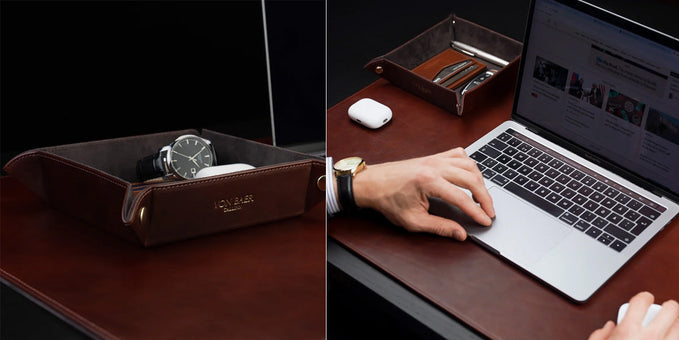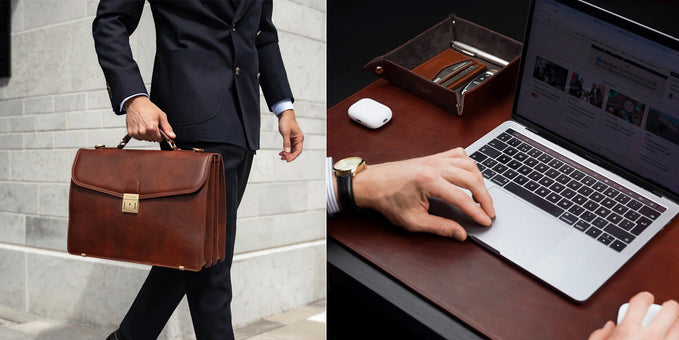How to Clean a Leather Wallet

Wallet looking worse for wear?
We've got you covered!
In this guide, we'll teach you how to clean and restore your leather wallet, so it looks like new again.
Why do wallets get dirty?
There are a few reasons why wallets can get dirty.
- If they are made of leather, they can absorb the oils from our skin, making them look grubby.
- Putting them in our pockets with loose change or other small items can rub against the wallet and leave marks or dirt behind.
- If we drop our wallets on the floor or ground, they can pick up dust, dirt and other debris.
What type of leather cleaner should you buy?

Full-grain and top-grain leathers often benefit from gentle, water-based cleaners that do not contain harsh chemicals.
Always test a small, inconspicuous area first to ensure the product does not alter the color or texture of the leather.
Brands like Leather Honey, Chamberlain's Leather Milk, and Bickmore are reputable in the leather care industry.
How to Clean a Leather Wallet:
1. Empty your wallet for cleaning

Empty all contents before cleaning leather wallets.
This will prevent any dirt or debris from getting trapped inside the pockets.
2. Identify stains and wipe down

The first step in cleaning a leather wallet is identifying the type of stain.
- If the stain is dry, you can use a dry, soft cloth to rub it away.
- If the stain is wet, you must use a damp cloth to wipe it away.
You may also need a mild soap or detergent if the stain does not come off easily.
3. Clean the leather surface with leather cleaner

- Apply a leather cleaner to a clean cloth and wipe down the entire surface of the wallet.
- Be sure to follow the instructions on the cleaner, as some require you to let the cleaner sit on the surface for a few minutes before wiping it off.
4. Air dry the moist surface
It is important to air dry a leather wallet after it becomes moist.
Wet leather can cause the material to break down and become damaged.
All you need to do is set the wallet on a dry towel or cloth and let it air dry.
You should never use heat to try and speed up the drying process as this can also damage the leather.
If possible, open the wallet so air can circulate inside and dry it out more quickly.
Once the wallet is completely dry, you can store it in a cool, dry place until you are ready to use it again.
5. Restore shine with conditioner

We recommend this leather conditioner for high quality leather products.
Apply a small amount of leather conditioner to a soft, clean cloth and gently rub it into the leather in circular motions.
This method ensures even distribution without over-saturating the leather.
After allowing the conditioner to penetrate the leather for a few minutes, buff off any excess with another clean cloth.
Using a clean cloth for both application and removal prevents dirt transfer and ensures the best care for your wallet.
6. Put it all back together
Now your wallet is ready and back to the life you are now allow to put your stuff back in your entire leather wallet.
With just a little care, you can keep your leather wallet looking new for years to come!
Wallet still not looking great? Invest in a luxurious full-grain leather wallet from Von Baer today.
Alternative Cleaning Solutions
For those preferring natural or household alternatives to commercial leather cleaners, a mixture of equal parts water and white vinegar can serve as an effective cleaner for removing light stains and buildup.
Olive oil mixed with lemon juice in a 2:1 ratio can be used as a natural conditioner to keep the leather supple.
However, be cautious with any homemade solution, and test it on a small area first, as some ingredients might not be suitable for all types of leather and could cause damage or discoloration.
Why is it Important to Clean the Leather Wallet?
It is important to clean the leather wallet because the leather will absorb dirt and oil from the skin, as well as any other materials that come into contact with it.
Over time, this will cause the leather to degrade and become brittle.
Also, cleaning the leather wallet will help remove any potential stains that could ruin its appearance.
Different types of leather

There are different types of leather, each with advantages and disadvantages. The most common types are full, top, genuine, and bonded.
Full-grain leather
Full-grain leather is the highest quality you can get. It's made from the outermost layer of the hide, so it's strong and durable. However, it's also the most expensive.
Shop full-grain leather wallets
Top-grain leather
Top-grain leather is a step down from full grain in terms of quality, but it's still quite good.
It's made from the second layer of the hide, so it's not as strong as full-grain leather. However, it's more affordable.
Genuine leather
Genuine leather is the lowest quality of the three main types. It's made from lower layers of the hide, so it's not as strong or durable as full-grain or top-grain leather.
However, it's the most affordable option.
Bonded leather
Bonded leather is a composite material made from lower layers of the hide that have been bonded together with adhesives.
It's not as strong or durable as full-grain or top-grain leather, but it's more affordable.
Cleaning Requirements for Different Types of Leather
Different types of leather require specific care methods:
- Full-grain leather, being the most durable and high-quality, benefits from minimal intervention and regular conditioning.
- Top-grain leather, while still high quality, may need more frequent cleaning to maintain its appearance.
- Genuine and bonded leathers, being less durable, require gentle cleaning methods and should be handled carefully to avoid damage.
Always refer to the manufacturer’s instructions for care recommendations specific to your wallet's leather type.
Frequency of Deep Cleaning vs. Regular Maintenance
Regular maintenance of a leather wallet includes wiping it with a dry cloth to remove surface dirt and applying conditioner every few months to keep the leather soft and prevent cracking.
Deep cleaning, involving more intensive methods such as using leather cleaner or a damp cloth for stain removal, should be done sparingly, only when necessary.
Over-cleaning can strip the leather of its natural oils, so it's important to balance keeping your wallet clean with preserving its material integrity.
Preventive Measures for Staining and Dirt Accumulation
To prevent stains and dirt from accumulating on your leather wallet, avoid placing it on unclean surfaces and minimize its exposure to potentially staining substances (like oily or dyed materials).
Consider using a protective spray designed for leather goods to add a barrier against dirt and moisture.
Regularly dusting off your wallet with a soft, dry cloth can also help prevent buildup.
Store your wallet in a breathable pouch when not in use to protect it from dust and direct sunlight.
Impact of Cleaning on Wallet Durability
Regular, gentle cleaning and conditioning can significantly extend the life of your leather wallet by keeping the material soft, preventing cracks, and maintaining its color.
However, excessive cleaning or the use of harsh products can dry out the leather, leading to brittleness and cracking.
It's essential to balance cleaning with preservation, ensuring that any products used are suitable for leather and applied sparingly.
Dealing with Saturated Wallets
If your wallet becomes fully saturated with water, gently blot away as much moisture as possible with a soft, absorbent cloth.
Avoid wringing or rubbing the leather. Open the wallet and allow it to air dry naturally away from direct heat and sunlight, which can cause the leather to warp or crack.
Once the wallet is dry, apply a leather conditioner to restore flexibility and protect the leather from becoming brittle.
Leather Wallet Storage
When not in use, store your leather wallet in a cool, dry place out of direct sunlight and away from heat sources, which can cause the leather to fade and dry out.
Consider using a breathable fabric bag to prevent dust accumulation while allowing air circulation. Avoid storing the wallet in a cramped space where it might become misshapen.
If you live in a humid climate, including a silica gel packet with your stored wallet can help absorb excess moisture and prevent mold growth.
How to wash a leather wallet With Soap And Water
- Mix 1/4 cup of soap with 1/4 cup of warm water to clean your leather couches or chairs.
- Apply the mixture to a clean cloth and rub it into the leather in a circular motion.
- Once you've worked up a lather, use a damp cloth to wipe away the soap.
- Then, dry the leather with a soft, clean cloth.
Household Ingredients For Cleaning Leather
You can use a few other household ingredients to clean leather, including vinegar, olive oil, nail polish remover and baby oil.
- Simply mix a solution of one part vinegar to two parts water, and use a soft cloth to wipe down the leather.
- For a more moisturizing solution, mix equal parts olive oil and lemon juice, and apply it with a soft cloth.
- Finally, baby oil can be used to remove tough stains from leather.
- Apply it to the stain with a soft cloth and rub it until it lifts.
- Lastly, you can use rubbing alcohol on the leather surfaces to remove hard stains.
How To Prevent a Leather Wallet From Cracking
If you want to prevent your leather wallet from cracking, you should:
- avoid exposure to direct sunlight or heat
- keep it away from water
- clean your wallet and condition your wallet every month with a leather conditioner, and leave your wallet to dry naturally
- store it in a cool, dry place
How often should you clean a leather wallet with a leather conditioner?
You should clean your leather wallet every few months to prevent it from looking dull and worn.
Use a soft cloth or brush to remove any dirt or debris, then apply a leather conditioner to keep the material soft and supple.
FAQS
Does vinegar ruin leather?
No, vinegar will not ruin the leather. Vinegar can be used to clean and condition leather. Be sure to dilute the vinegar with water before applying it to the surface of your wallet.
Can you put a leather wallet in the washing machine?
No, it would help if you did not put a leather wallet in the washing machine. This can damage the wallet and cause it to break down. Instead, if you need to clean your leather wallet, spot clean it with a damp cloth and mild soap.
**Note: The information offered here is for informational purposes only and may not be suitable for all situations.

Author: Igor Monte
Igor Monte is the co-founder of Von Baer. He's an expert in all things premium leather, from being an end-user right up to the design and manufacturing process. His inside knowledge will help you choose the best leather product for you.
We strive for the highest editorial standards, and to only publish accurate information on our website.
Leave a Comment
Your email address will not be published.






